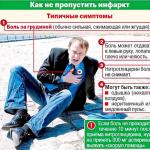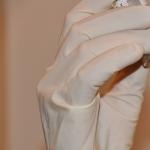It is necessary to know what symptoms and signs of progressive myocardial infarction exist in order to provide first aid to the injured party in a timely manner. It is required to act immediately, otherwise the patient will face a sudden death. The characteristic signs of myocardial infarction in women are similar to other heart diseases, so there is an urgent need for differential diagnosis. With pain symptoms, additional drug therapy is clearly indispensable.
What is a heart attack
Ideally, oxygen-enriched blood enters the myocardium through the coronary vessels, thereby providing an acceptable systemic circulation. If the patency of the vascular walls under the influence of pathogenic factors is impaired, oxygen starvation progresses with the further formation of foci of necrosis on the heart muscle. With the growth of foci of pathology, the function of the heart is disturbed, and this pathological process in modern cardiology is called myocardial infarction. The disease has severe symptoms, needs timely therapy, resuscitation measures.
How does a heart attack manifest?
The main goal of the patient and the doctor is to avoid ischemic necrosis, to normalize the systemic circulation. Otherwise, the number of heart attacks increases and the patient may die unexpectedly. Therefore, it is necessary to pay attention already to the first symptoms of a heart attack, which even change the appearance of the patient, making the skin pale and the eyes blurred. Other signs of damage to the coronary vessels are presented below:
pressing pain in the sternum;
- reduced blood pressure;
- confusion, accompanied by dizziness;
- soreness and heaviness of the muscles;
- slurred speech, unconscious behavior;
- panic attacks, fear of death;
- shortness of breath with the appearance of shortness of breath.
Symptoms of myocardial infarction
Such painful attacks are more common in women aged 45 years and older, but this does not mean at all that this diagnosis is not characteristic of men. The pathological process is accompanied by high blood pressure, and may end with myocardial ischemia. Doctors identify the following precursors of a heart attack:
- frequent shortness of breath with minimal physical exertion;
- a tight feeling in the chest;
- angina attacks;
- increased sweating;
- acute lack of oxygen;
- forgetfulness, loss of orientation in space;
- muscle weakness.
Among women
Modern women over 45 years of age are faced with a high probability of myocardial infarction against the background of reduced stress resistance, hard physical labor. The characteristic signs of ischemic necrosis in the female body differ from the course of the disease in men, and a violation of the blood supply to the heart muscle causes not only acute pain, but also other signs of the disease. This:
- shortness of breath during sleep, snoring;
- disturbed water balance, which precedes swelling of the face, hands, feet;
- violation of the heart rhythm, as in arrhythmias;
- frequent urination at night;
- numbness of the limbs;
- nausea, bouts of vomiting;
- increased frequency of migraine attacks;
- stomach pain;
- pain radiating to the left shoulder.
The nature of the pain
This is one of the most dangerous cardiac pathologies. With extensive heart attacks, there is definitely an acute pain syndrome that disrupts breathing, bedridden, paralyzes consciousness and restricts movement. Sharp pain is accompanied not only by dizziness, but also by an unconscious state, especially when it comes to women. The first step is to call an ambulance, carry out a series of resuscitation measures, and start treatment in a timely manner. Otherwise, the pathological process of necrosis in the tissues of the myocardium can cost the patient his life.
Feel
An attack of acute ischemia begins with unexpected pain in the heart, which radiates to the left shoulder, does not disappear after taking painkillers. At the initial stage, these are irregular backaches, which, in the absence of therapeutic measures, remind themselves again and again. It is possible to recognize a heart attack by the nature of the pain, since in the stage of relapse it does not let go of the clinical patient.
Signs of myocardium
Symptoms before a heart attack suggest thoughts about a progressive pathological process, they occur in a few days - a month. To avoid dangerous complications, it is required to respond to alarming signs immediately, otherwise the death of the patient is among the consequences. So, progressive necrosis of the heart muscle and preinfarction are accompanied by:
- uneven breathing at night, snoring, shortness of breath;
- pain in the left shoulder, numbness of the extremities;
- systematic attacks of arrhythmia;
- increased bleeding gums;
- Strong headache;
- swelling of the lower extremities;
- increased urge to go to the toilet.
A patient with a heart attack feels out of place, unable to control his own actions and deeds. He does not feel the limbs, speaks indistinctly, behaves inappropriately. Because of the acute pain of the heart, breathing is difficult, becomes frequent, but intermittent. The patient is required to take a horizontal position, and others should immediately provide emergency care to the core.

Nervous signs
The pathological process involves the organs of the central nervous system, which are supplemented by atypical symptoms, reduce the quality of life of the patient, require immediate hospitalization. After timely diagnosis, it is possible to stabilize the general condition of the clinical patient, the main thing is not to engage in superficial self-treatment. So, the characteristic signs of the disease are as follows:
- cold sweat;
- decreased visual acuity;
- tremor of the limbs;
- numbness of the limbs;
- migraine attacks;
- dizziness;
- internal panic and fear;
- obsessive thoughts about death;
- chronic insomnia;
- paresthesia of the upper extremities.
The first signs of a heart attack
A patient with a heart attack begins to feel bad, and the first sign of a characteristic ailment is loss of sensation in the limbs, numbness of the tongue. There are no painful sensations, but the pressing feeling in the chest is pretty disturbing. If the patient is not provided with qualified assistance in time, he will have to fight with severe pain syndromes that remind of themselves again and again. With myocardial damage, acute attacks are accompanied by nausea, other initial signs of the disease are presented below:
- lowering blood pressure;
- disturbed phase of sleep;
- chronic fatigue;
- instability of the heart rhythm;
- frequent cephalgia;
- frequent urination at night;
- increased swelling.
Clinical picture of atypical cases
If the signs of this disease are non-standard, it is somewhat more difficult to diagnose a progressive heart attack. For example, patients with diabetes mellitus, chronic diseases of the cardiovascular and respiratory systems may face such a problem. The attack is accompanied by unexpressed symptoms, so help to a person may be belated. Atypical signs are presented below.


